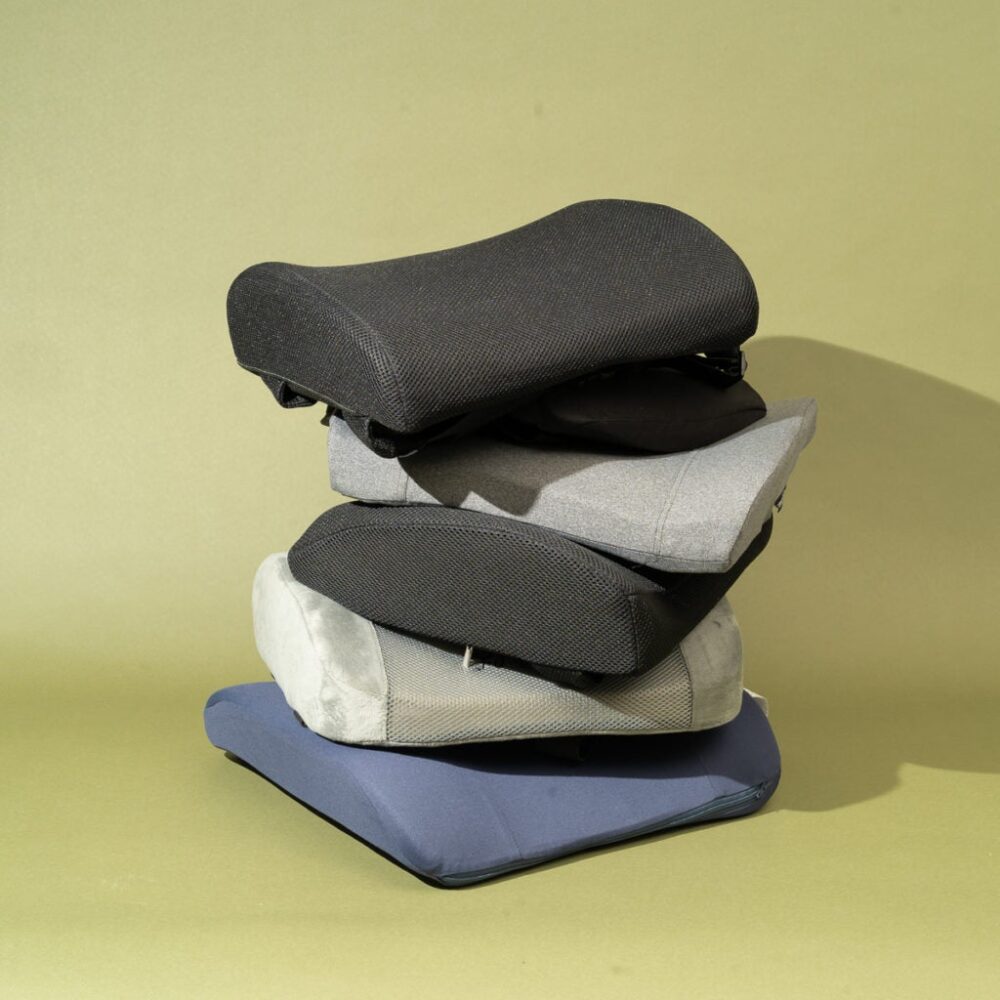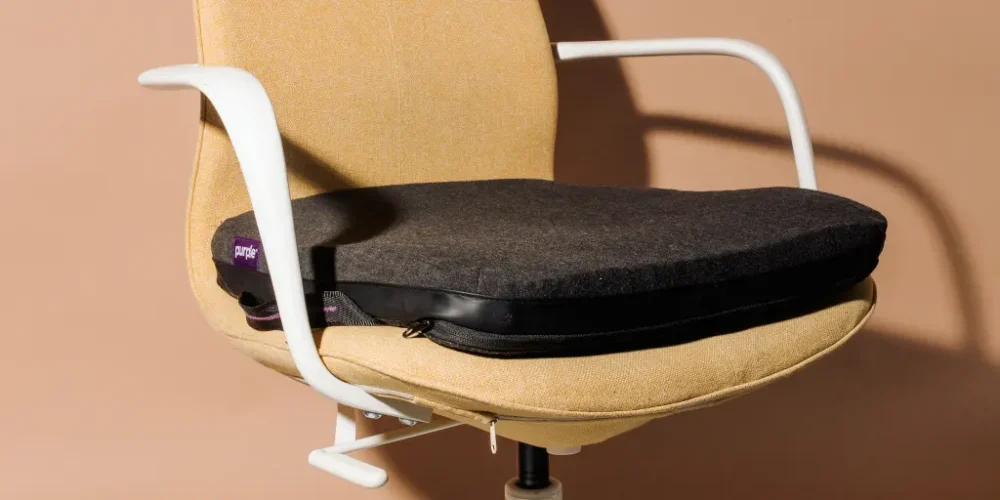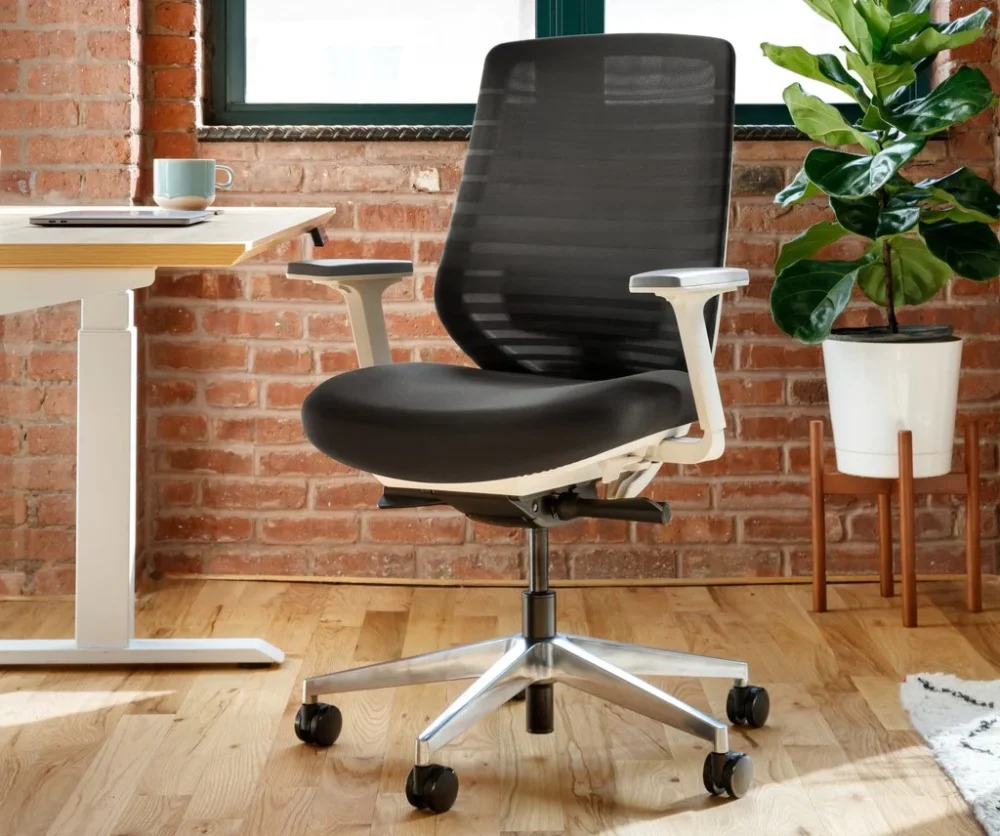If you’re in the market for a new office chair, you’re well aware of the fact that this seemingly small purchase can have a huge effect on your daily life — it could literally mean the difference between an excruciatingly uncomfortable work day and a work day that’s much more bearable.But before you can enjoy the perfect counterpart to your standing desk, you’ve got to take a moment to conduct the research that’s necessary to ensure you get the absolute best office chair for your specific needs. No worries though — we’ve got you covered.Welcome to your ultimate guide to choosing the best office chair for you! Here you’ll find helpful tips for finding a chair that not only meets your unique requirements, but also fits your budget. From desk chairs for home offices to chairs for larger corporate offices, you’ll learn everything you need to know to make the perfect purchase. You’ll be sitting pretty in no time!
When selecting the most comfortable home office chair, it is important to assess the level of adjustability available. This is because a chair that cannot be adjusted to the user-specific needs of an individual’s body size, can cause poor posture and discomfort. Fortunately, there are many office chairs on the market today with adjustable features. A few of the specific adjustable features available to look for when choosing an office chair include:
- Seat Height Adjustment: One important adjustable feature to look for in an office chair is seat height adjustment. This feature allows individuals to automatically or manually adjust the height of their seating surface by a lever or push button mechanism, so that it meets their own individual comfort. This is especially important for people of different heights who have to work within the same space, as they can all adjust their seating surface heights accordingly.
- Backrest Adjustment: Most modern office chairs come with a reclining backrest that allows users to adjust their preferred angle of sitting. This ensures individuals are able to maintain proper posture, while also providing additional comfort during prolonged periods of sitting.
- Armrest Adjustment: Armrests should also be customizable since arm positions play an important role in maintaining correct posture while typing and using a mouse. If an armrest is not adjustable it should at least be properly shaped and cushioned, so it correctly supports the user’s forearms and elbows when typing. Many ergonomic chairs come with adjustable armrests that not only move up and down but can also slide backward and forward for those who desire even more comfort.
- Lumbar Support Adjustment: Most quality ergonomic office chairs offer some type of lumbar support adjustment; either manual or automatic adjustments controlled by a lever mechanism located beneath the seat itself . Having your chair adjusted properly can improve your circulation, reduce fatigue and ultimately enhance your overall productivity. Overall, having some form of adjustability in an office chair is essential for proper health and reduced workplace fatigue over time; especially if you plan on spending a good portion of your day seated behind your desk.
Therefore, when comparison shopping for office chairs make sure to pay close attention to the type of adjustable features offered in each one you consider buying. The next piece in this guide will discuss how different adjustable height options can help maximize user comfort and effectivity while working from home or in office spaces.
Highlights
When selecting an office chair, it is important to look for adjustable features like seat height, backrest, armrest, and lumbar support. Having adjustable features in an office chair is essential for proper health and increased productivity over time. Different adjustable options can help maximize user comfort when working from home or in office spaces.
Adjustable Height

Source: steelcase.com
The adjustable height feature of office chairs is essential for comfort and ergonomics. Users should be able to easily adjust the height so that their feet are flat on the floor, with legs at 90-degree angle and elbows at a comfortable height in relation to the desk. It is important to choose an office chair that goes high enough to accommodate taller users, while also going low enough for those who are shorter. Without adjustable height, there will be awkward postures that can cause discomfort and even lead to long-term body aches, fatigue and musculoskeletal disorders. In addition, adjustable heights make it easier to switch between people in a collaborative work environment. When considering a chair’s adjustable height, you should check that it reaches the required maximum of 35 inches from the floor or whatever your preferred sitting height is. Also make sure the adjustment lever is easy to reach and operates smoothly. Be sure to take into account both the minimum and maximum heights when choosing a chair for someone short or tall. Finally, remember that many office chairs require assembly after purchase, and sometimes adjusting the seat’s pneumatic lift mechanism will also be necessary for optimal comfort and proper fit. Having considered the adjustable height of an office chair, the next step is to look at “Adjustable Arms”. The ability to customize armrests is key in providing additional support while seated at a desk all day.
Adjustable Arms
Adjustable arms can have a big impact on the use of an office chair. They are designed to help create a user-friendly workspace as they reduce the strain on the arms, shoulders, and back from constantly reaching for the desk or leaning out of the chair. Having adjustable arms also provides support when users type or work on their computers for extended periods of time. With adjustable arms, an office chair can be customized to fit each individual’s needs and make sure that the right posture is maintained while working. The pros of having adjustable arms include: the ability to customize your chair according to individual preferences; improved posture; added comfort; and less strain on the back, arms, and shoulders. On the other hand, adjustable arms may add cost to the overall purchase price and there are certain users who might not need or benefit from having these features. In conclusion, adjustable arms offer many benefits and should be considered when selecting an office chair that meets our individual needs. Moving ahead in this guide we will take a closer look at adjustable tilt, a feature which provides greater flexibility when it comes to ergonomics in your workspace.
- According to a recent survey, the majority of employees surveyed spend more than 6 hours a day in their office chair.
- Studies have shown that having an ergonomic desk chair can reduce back pain and fatigue by up to 54%.
- A 2019 report from the American Chiropractic Association suggested that poorly designed office chairs can increase the risks for musculoskeletal disorders.
Adjustable Tilt

Source: stealthoptional.com
Adjustable tilt is an important factor to consider when choosing an office chair because it impacts the overall comfort of your chair while working. The level of adjustable tilt affects the size of your seat, the amount of back support you receive and whether or not your chair can fit in smaller spaces. The most common type of adjustable tilt mechanism is the lever-activated tilt lock. This type of mechanism allows for easy adjustment by simply pushing a lever up or down to adjust the recline angle. Additionally, it creates the best ergonomic posture by allowing you to recline up to 15 degrees from an upright position. This allows for improved circulation, reduced pressure on the neck and spine and increased comfort during long periods of sitting. There are pros and cons to adjustable tilt mechanisms however, as they may also encourage bad posture by allowing users to recline too far forward, placing extra strain on the lower back. Additionally, they can be noisy when adjusting and some models can be quite large in terms of size and cost significantly more than non-adjustable chairs. Ultimately, adjustable tilt mechanisms should offer enough necessary adjustments so that the user won’t slip into an unfavorable posture which could lead to health complications over time. Armed with this information, you can now make more informed decisions regarding whether or not an adjustable tilt chair is right for you. Next we’ll examine how ergonomic design features can make an office chair even more comfortable.
Ergonomic Design Features
The ergonomic design features that come on an office chair are crucial in maintaining comfort and long-term health. When selecting a chair, it is important to consider the following:
- Adjustability: The ideal office chair has adjustability features including adjustable seat height, armrests and backrest recline tension. Having the right ergonomic settings can be key in avoiding muscle fatigue and poor posture.
- Lumbar Support: Many office chairs have built in lumbar support. Look for adjustable lumbar supports, which will provide more control of the support for your lower back. This support helps to keep your spine aligned and prevents pain and discomfort from prolonged sitting.
- Head Rest: An adjustable headrest can help reduce neck strain and improve posture by promoting a more upright position as you type at a desk. This feature is great for those who tend to lean forward when typing for extended periods of time; however, some people find headrests uncomfortable due to the increased pressure on the back of their head.
- Back to Basics Features: Even though they may not seem like “ergonomic” features per se, having basic features such as swivel capabilities and caster wheels are essential when choosing an office chair. It is important to be able to move around with ease in order to readjust postures and reach new working positions during the day. Overall, choosing an ergonomically designed office chair can greatly improve comfort and productivity during long hours spent at the desk. With adjustable lumbar support, adjustable armrests and swivel capabilities being aspects that can increase comfort while providing long-term health benefits, it’s worth investing in a high-quality ergonomically designed chair.
The importance of lumbar support cannot be overstated when it comes to selecting an office chair – because without proper lumbar support, many individuals find themselves developing chronic pain due to incorrect posture over time. In the next section, we’ll examine the various types of lumbar support available in office chairs today and discuss how you can find the right one for you.
Lumbar Support

Source: nytimes.com
When choosing an office chair, lumbar support is one of the most important features to consider. A well-supporting chair is integral to maintaining good posture and can help prevent back pain over time. Depending on your individual preferences, you may benefit from a chair with built-in pads or adjustable lumbar support.In general, experts agree that adjustable lumbar support is preferable for long-term use. The adjustable feature allows for users to customize the feel of the chair to their individual needs. This personalized approach helps maintain good posture and provides better overall ergonomic benefits. However, static chairs with built-in lumbar support may be more comfortable for those who don’t want to invest in an adjustable chair or fiddle with tightening features. Whether you choose an adjustable or static version with built-in support, it’s wise to look for a chair that offers good lower back support and helps promote good posture. Though costs may vary, quality lumbar support doesn’t have to break the bank as there are companies offering budget-friendly options that still provide top-notch ergonomic benefits. Now that we’ve discussed the importance of lumbar support, let’s move onto another key factor in selecting the best office chair: comfort and upholstery.
Comfort and Upholstery
Comfort and Upholstery are two important components to consider when choosing an office chair. Upholstery provides the aesthetic for the chair as well as importantly, support for users’ backs and arms. But, comfort is also a key factor in making sure users don’t experience back pain or fatigue that is associated with long-term seating. When it comes to upholstery, there are typically four types of material used: leather, mesh, microfiber, and fabric – each offering different advantages and disadvantages. Leather chairs offer a classic look but can absorb body heat and have higher up-front costs. Mesh chairs are lightweight and breathable but can be noisy when leaned upon. Microfiber chairs provide a softer fabric than leather but will not last as long unless maintained properly. And lastly, fabrics such as polyester offer some repel water or liquid spills but may tear easier than other materials. Cushioning is another factor to consider when evaluating overall comfort levels for office Chairs.
Generally, more cushioning indicates more comfort – so look for chairs with thick armrests, contoured cushions and adjustable lumbar support settings to make sure you’re comfortable for hours on end. Too little cushioning can result in numbness or misalignment of the spine due to poor posture; too much cushioning can cause user discomfort from sinking too deep into the chair and feeling stiff at times. To ensure optimal comfort levels, it’s important to do research on the type of upholstery used, review customer feedback on comfort level ratings and take into account any pre-existing health conditions that might impact what features may or may not work best. Now that we’ve discussed Comfort and Upholstery, let’s move onto another important factor – Cushioning and Upholstery!
Cushioning and Upholstery

Source: nytimes.com
When considering the cushioning and upholstery of an office chair, it is important to think about ergonomic needs as well as personal preference in terms of material, comfort and color. Different materials offer different levels of support, bounciness and breathability.Foam is the most common material used when it comes to office chair padding and upholstery. It is lightweight, often relatively inexpensive and provides adequate ergonomic support depending on its density. Memory foam has become increasingly popular in recent years due to its molding capabilities and spring-back characteristics that make it easier to get out of the chair without overexerting oneself. Foam does not last as long as other more durable materials like leather or mesh, however, so buyers should factor this potential longevity issue into their final decision.Leather is another popular option for upholstery on office chairs – it gives off a classic look and provides good breathability.
Generally speaking, leather also tends to last longer than other cushioning materials which helps to add value to your investment over time. The downside is that traditional leather can be uncomfortable in hot weather due to its tendency to retain heat more than other materials like mesh or fabric.Mesh is a newer entry onto the cushioning scene but is rapidly gaining traction due to its durability and comfort benefits. Mesh fabrics are highly breathable which allows cool air to circulate around your body while sitting so you don’t end up with a sweaty back after hours of work. While some may find mesh less comfortable than other materials at first, it tends to break in easily and provides just enough softness without sacrificing any support like foam or leather options do over time. However, when considering this material it is important to keep price in mind as it generally costs more than other options.
Personal preference should also play a role in selecting cushions or upholstery for your office chair since these factors heavily influence how comfortable you will be throughout your day-to-day work tasks. From fabric choices to color palettes, there are many things to consider when selecting the best seating option for you – all it takes is good research and thoughtful consideration of your lifestyle habits!Having discussed cushioning and upholstery for office chairs, let’s move on to explore personal factors that affect the buying decision, such as posture support, adjustable height and tilt mechanism in the next section.
Personal Factors
When choosing a chair for the office, personal factors should not be overlooked. This includes how tall you are, your weight, and body type. For example, if you have larger legs or a wider back, you’ll want to make sure the chair’s seat has enough room to accommodate you without becoming uncomfortable after extended periods of sitting. On the other hand, if you’re petite in stature and size, you may want to find a chair that allows for daily adjustability—particularly in terms of height. Those with posture concerns may also need extra consideration when it comes to personal factors. If sitting for long periods of time puts strain on your back or neck, look for chairs with adjustable lumbar support and padded headrests for added comfort and to promote proper spine alignment. It’s also important to consider which position you usually assume while working at your desk; if you communicate with clients or colleagues from your chair often enough, swivel features play an important factor as well.
In addition, look for a chair that offers sufficient cushioning: don’t let cheap foam-based materials deceive you as inferior quality often means compromising comfort and longevity. Memory foam can be an excellent option as it maintains its firmness over time—another attractive perk beyond comfort itself.Finally, aesthetics should be taken into account too; do you prefer contemporary look? Soft fabrics instead of synthetic materials? A range of colors and designs? Your office space is a reflection of yourself and these details add personality to your workplace.It is immediately clear that there are multiple personal factors at play when considering a new office chair—not only in terms of practicality but also convenience in order to better match individual needs and preferences. Now let’s look at your type of work and what this entails when it comes to finding the best office chair for you.
Your Type of Work

Source: branchfurniture.com
When choosing the perfect office chair for your needs, it’s important to consider what type of work you do on a regular basis. It’s possible that an ergonomic office chair could be ideal for you if you’re often sitting in a chair for long periods of time or are lifting heavy objects. An ergonomic chair is designed to provide lumbar support and offer adjustable features such as height, arms and back positions. However, some people prefer a more basic office chair with simple features such as adjustable height and trimmable armrests if they don’t need the extra lumbar support.
The choice ultimately comes down to an individual’s specific needs; however, regardless of which direction you choose to go, it’s important to look for chairs that have multiple locking positions so that you can find the most comfortable setting. While ergonomic chairs may have an upfront cost, they are often worth the investment as they help to improve posture and prevent long-term strain on your body from remaining stationary in one position for too long. No matter which type of office chair fits your lifestyle the best, always make sure to regularly test it out before settling on a purchase decision. Trying it out will allow you to experience its comfort level and ensure that all of its features work properly as well. Once you feel confident in your decision and have found the right fit for both your budget and body type, then you can move onto the next step: deciding what type of materials and wheels are best suited for your chosen chair.
Chair Material and Wheels
When it comes to a chair’s material, it is especially important to consider the purpose and duration of sitting in the chair. For instance, if you are going to be sitting in your office chair for an extended period of time every day, it’s essential to look for a model made with a breathable fabric or upholstery that offers not only comfort but also helps to regulate body temperature. On the other hand, if you mainly stay at home or use the chair occasionally, then leather or faux-leather materials may be just as comfortable.The advantage of chairs with leather upholstery is that they tend to be much more durable than chairs upholstered with fabrics, which wear out faster due to the constant contact with body heat. Additionally, leather chairs typically have higher price points than those made with fabrics. Similarly, wood frames tend to last longer than other types of materials such as steel and aluminum.
To ensure maximum comfort for your back, make sure the chair has padding that supports both your lower lumbar area and upper back muscles.Since wheels have become an integral part of any office chair design today, many models come equipped with a variety of wheel options. Soft rubber or plastic wheels are great for carpets or rugs because they provide traction and prevent the chair from sliding around on smooth surfaces like hardwood or tile floors. However, hard casters are beneficial if you need to move quickly across your workspace or frequently transition between various work surfaces. Keep in mind that most office chairs nowadays will come with a locking mechanism to keep them securely in place while sitting.In conclusion, when choosing an office chair it is important to consider both its material and wheel base so that you gain optimal comfort and durability while working long hours in your workspace. This allows you to ensure you are making an informed investment in your seating needs that will last for years to come. With this knowledge in mind, let us now turn our attention towards what conclusions can be drawn on what to look for in an office chair.
Conclusion on What to Look for in an Office Chair
When choosing the perfect office chair, it’s important to consider how active you are in the office. Some people may require more ergonomic chairs that provide better support and adjustability, while others may prefer extra padding for comfort. Ultimately, the best chair for you depends on your individual needs, lifestyle, and budget.First, take a look at your current level of physical activity. If you typically find yourself leaning forward or standing a lot when you work, then an ergonomic office chair with adjustable features such as adjustable armrests and lumbar support might be ideal. Whereas if you tend to be more sedentary while working, then an upholstered executive chair with plenty of cushioning could be a better choice.Second, consider your lifestyle needs. If you’re constantly on the go, you may want a lightweight office chair that’s easy to move around with you.
On the other hand, a heavy-duty model might be more appropriate if you need to accommodate heavier individuals or do a lot of long hours at your desk.Third, think about your overall budget for the purchase. It’s always good to consider how much you’re willing to spend on an office chair before making any decisions. While there are many expensive models available, there are also options that won’t break your bank account but will still provide good quality seating solutions.Finally, make sure to check reviews from expert sources as well as online customer feedback before buying an office chair. This can help you gauge how comfortable and durable each model is likely to be based on how other users have rated it while also giving you an idea of the company’s customer service practices. With all of this information in mind, it’ll be much easier to determine which office chair is right for you!












